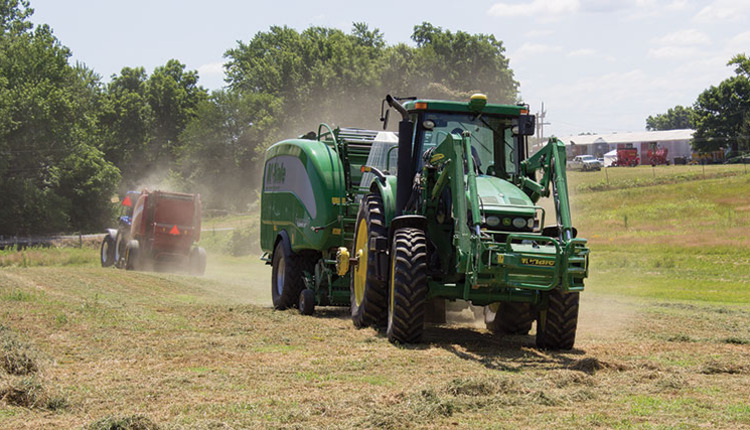
We’ve been really busy at our store this spring with customers who are chopping haylage, planting corn, and making baleage. We’ve sent out numerous pieces of new and used equipment. One piece of equipment that has become more difficult to order because of ever-expanding available options is the round baler.
In years past, the only considerations entailed bale size, the number of bales produced per year, and the make or model of the baler.
These days, ordering your next round baler has an order sheet that almost mirrors that of a tractor. Items to consider include pickup sizes, tire and axle options, net wrap capabilities, and precutters. Let’s break it down and take a look at some of these considerations.
Bale size is the first important option that deserves some thought. With baleage becoming more popular each year, smaller bales are needed to limit the additional weight created by the higher moisture content. On our farm, we averaged almost 2,100 pounds per bale on our first cutting of ryegrass harvested in a 55-inch bale. That’s much different than a 900-pound bale of dry hay.
Bale size needs to match the capability of the handling equipment. If you are currently baling wet hay and making less than a maximum size bale, give a smaller baler some consideration. I know you will be happy with the price compared to a larger 5-foot by 6-foot baler and it might allow for adding some of the other options that we will discuss.
Width matters
The next decision that has been made available in the last 10 years is pickup width. Most every model now has several wide pickup options. Wide pickups make the baler driver and rake operator’s life less complicated. These large pickup options work well, but they are more expensive and some have more parts than others. I would suggest looking at a camless pickup when selecting options, as they have fewer parts, typically turn faster, and often do a better job picking up various forage lengths and crops.
A majority of baler owners have made the switch to net wrap. Twine-tie systems are still effective but, in my opinion, net wrap is the only way to go.
In addition to twine and net wrap, there are also a few different types of cover wrap. One that has both net and plastic wrap is geared for dry hay. This is a great option for ranchers who must store their hay outside all winter. Though it’s a little more expensive, it can be cheaper than building a barn.
Another option that comes from Europe is plastic wrap designed for baleage. This material originated mainly in Ireland where they recycle most of their plastics, and the net wrap and plastic wrap could not be recycled together. With this plastic wrap system, which is offered from several manufacturers, the same type of plastic is used. This type of plastic only works in wet hay (baleage) scenarios because the sticky side of the plastic does not work well with the dust when baling dry hay.
Adding knives
Precutter knives have also seen a sales boost in the last few years. As baleage gains momentum, so do balers with knives. There are a few options and ways to order the knife package, so be sure to get the one that fits into your budget. A typical cutter option on a baler with the drop floor to clear out clogs will cost about $5,000 to $6,000. Speaking from experience, it’s worth every penny. You save time, fuel, and wear on vertical mixers.
On our farm, we saw both higher bale weights and better forage quality when comparing our chopping baler to our nonchopping baler. In our experience, this was due to improved bale density and crop fermentation. Our bales were around 250 pounds heavier, and we only had half of the knives engaged.
Adding a cutting system changed the way we fed baleage; that was also the case for one of our dairy customers who had to change their ration when they began feeding the processed baleage. They experienced improved quality and dry matter intake. A cutting system may not be needed in your current operation, but it may be something to consider for the future.
One of the latest options to come over from the large square bale world is an accumulator for round balers. Though still relatively new to the market, accumulators can be a real time saver when collecting bales and reduce the amount of wheel traffic on fields. These accumulators will soon be standard for all custom balers and larger operations.
The next time you’re in the market for a new baler, make sure you take a good look at the many options now available. It’s a much different buying process than it was just a few short years ago. Good luck this summer in the hayfields.
This article appeared in the April/May 2018 issue of Hay & Forage Grower on page 19.
Not a subscriber? Click to get the print magazine

